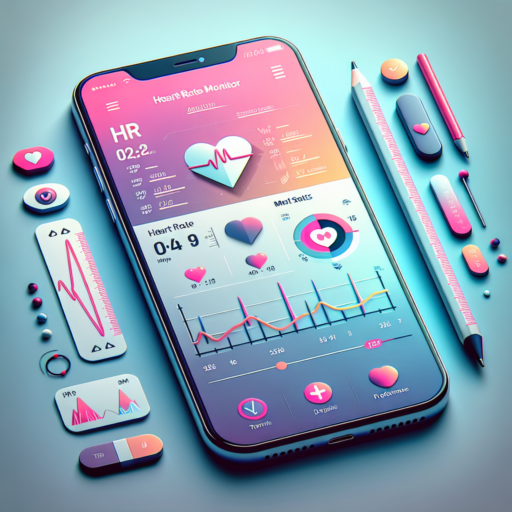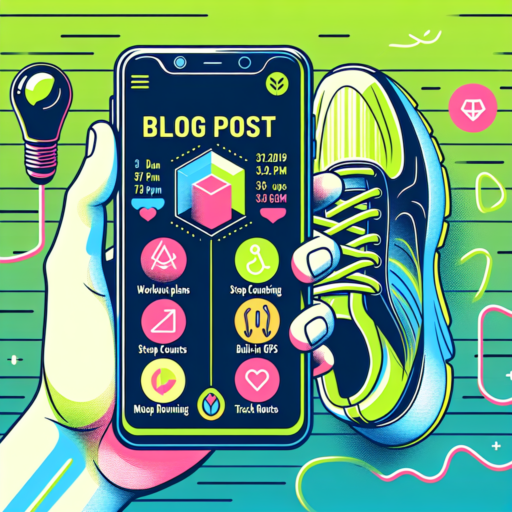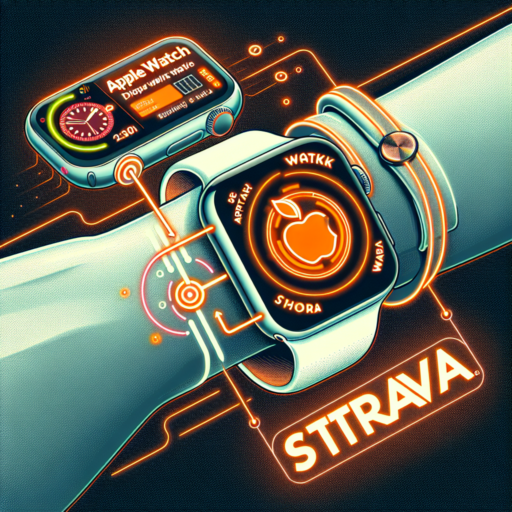What is an HR Monitor App and How Does it Work?
An HR Monitor App, standing for Heart Rate Monitor Application, is a digital tool designed to measure and record your heart rate in real-time. Leveraging the power of smart technology, these applications work by using sensors found in smartwatches, smartphones, or dedicated heart rate monitoring devices. The primary function is to provide users with instantaneous data about their heart’s performance during various activities, including exercise, rest, and even sleep.
At its core, an HR Monitor App operates through a process called photoplethysmography. This method involves the app’s sensors emitting a light that penetrates the skin and reflects off the blood vessels. By calculating the changes in light absorption caused by the blood flow, the app can accurately determine the heart rate. This technology not only offers a non-invasive way to monitor heart health but also provides valuable insights into one’s overall fitness levels and cardiovascular condition.
Moreover, HR Monitor Apps often come with additional features designed to enhance the user’s health and fitness journey. These might include the ability to set personalized heart rate zones, track heart rate trends over time, and receive notifications for when the heart rate exceeds or drops below certain thresholds. By integrating these functionalities, HR Monitor Apps serve as comprehensive tools for individuals looking to improve their physical well-being, monitor their progress, and achieve their fitness goals more effectively.
Top Features to Look for in a Heart Rate Monitor App
When selecting the perfect heart rate monitor app, it’s essential to consider the features that will best suit your fitness and health monitoring needs. Advanced heart rate monitor apps offer a range of functionalities designed to provide comprehensive insights into your heart health and exercise performance. Below are some critical features to consider.
Real-Time Heart Rate Monitoring
One of the fundamental features to look for is real-time heart rate monitoring. This feature enables users to track their heart rate continuously during workouts, providing immediate feedback on their cardiovascular effort and intensity. It helps in optimizing workouts and ensuring that users are training within their target heart rate zones for maximum benefit.
Historical Data Analysis
Another essential feature is the ability to analyze historical heart rate data. This functionality allows users to review their heart rate trends over time, giving insight into overall heart health improvement or identifying potential issues early. By examining patterns, users can adjust their training and lifestyle habits for better heart health outcomes.
Integration with Other Apps and Devices
- Compatibility with wearables and other fitness tracking devices ensures that users can sync their data seamlessly for a holistic view of their health.
- Integration with fitness and health platforms can enhance the user experience by enabling a comprehensive health monitoring ecosystem, pairing heart rate data with other health metrics.
5 Best HR Monitor Apps in 2023: An In-depth Review
Keeping track of your heart rate is an essential aspect of fitness and overall health management. With the evolution of technology, HR (Heart Rate) monitor apps have become increasingly sophisticated, offering a variety of features to suit different needs. In 2023, we have witnessed the emergence of some standout apps that not only track your heart rate but also provide detailed insights into your physical condition and progress. In this article, we delve into the 5 best HR monitor apps of 2023, showcasing their unique features and how they cater to the dynamic needs of fitness enthusiasts.
Comprehensive Analysis & Personalized Recommendations
Among the top contenders is an app that sets itself apart by offering a comprehensive analysis of your heart rate data. This app goes beyond simple tracking; it uses artificial intelligence to give you personalized health and fitness recommendations. What makes it even more appealing is its user-friendly interface and compatibility with a wide range of devices, ensuring you can monitor your heart rate anytime, anywhere.
Real-time Monitoring & Interactive Challenges
Another app that has captured the attention of health aficionados is known for its ability to provide real-time heart rate monitoring. It stands out by offering interactive challenges that motivate users to achieve their fitness goals. This feature encourages consistent monitoring, promoting a more active lifestyle among its users. Additionally, the app’s social sharing feature enables you to connect with friends and family, fostering a community of health-conscious individuals.
Choosing the right heart rate monitor app can be a transformative step in managing your health and fitness journey. Each app on our list comes with its unique set of features aimed at empowering users with insightful data and engaging experiences. From comprehensive analyses to real-time challenges and social connectivity, these apps provide versatile tools to help you stay on top of your heart health in 2023.
The Benefits of Using an HR Monitor App for Your Workouts
Integrating an HR (Heart Rate) monitor app into your workout routine can significantly enhance the effectiveness and safety of your exercise regimen. These apps are designed to help individuals track their heart rate in real-time, providing invaluable insights that can be used to optimize performance and health outcomes. By understanding the benefits of using an HR monitor app, users can make informed decisions about incorporating such technology into their fitness journeys.
Personalized Workout Intensity
One of the key advantages of using an HR monitor app is the ability to tailor your workout intensity based on your personal heart rate zones. These zones are typically determined by the app, factoring in your age, fitness level, and goals. By training within the correct heart rate zone, you are more likely to achieve your fitness objectives, whether it’s fat burning, endurance improvement, or cardiovascular health. This personalized approach ensures that each workout is both efficient and effective, reducing the risk of under or overexertion.
Trackable Progress and Motivation
Another benefit of leveraging an HR monitor app during workouts is the capability to track your progress over time. Seeing tangible improvements, such as a lower resting heart rate or the ability to exercise at a higher intensity without exceeding your target heart rate, can be incredibly motivating. This quantifiable feedback often encourages users to adhere to their fitness routines, making it easier to achieve long-term health and fitness goals. Additionally, many HR monitor apps offer features like goal setting and sharing achievements, further enhancing motivation through a sense of community and accomplishment.
How to Use a Heart Rate Monitor App to Improve Your Fitness Goals
Integrating a heart rate monitor app into your fitness regime can be a game-changer in achieving your goals. These apps are designed to provide real-time feedback on your heart rate, helping you to customize your workouts according to your body’s response. By tracking your heart rate, you can ensure that you’re exercising within the optimal heart rate zones for fat burning, endurance building, or cardiovascular health.
Setting Up Your Heart Rate Zones is the first step to maximize the benefits of a heart rate monitor app. Most apps allow you to input personal data such as age, weight, and fitness level to calculate your maximum heart rate. From there, the app divides your heart rate into zones: warm-up, fat-burning, cardio, intense, and maximum. Training in these specific zones can help you focus on particular fitness goals, such as improving aerobic capacity or increasing metabolism.
Moreover, heart rate monitor apps empower you with data to Adjust Your Workouts for better results. If you notice that your heart rate is consistently too high or too low during certain activities, it might be time to modify your exercise intensity. For instance, you might need to push harder during your cardio days or add more recovery time to prevent overtraining and reduce the risk of injury.
Comparing Free vs. Paid HR Monitor Apps: Which is Right for You?
When it comes to tracking your heart rate, technology offers us a myriad of options, from wearable devices to mobile apps. The debate between free vs. paid HR monitor apps is ongoing, with each category offering distinct features and benefits. In understanding which is right for you, it’s crucial to delve into what separates these two options.
Functionality and Features
Firstly, free HR monitor apps often provide basic tracking functionalities. These include monitoring your heart rate in real-time, logging exercises, and sometimes, offering insights into your health trends. On the other hand, paid apps tend to offer a broader range of features. Enhanced analytics, personalized training programs, and more detailed health reports are common in many paid versions. The distinction lies in how in-depth you require your data and analytics to be for your training or health monitoring.
Accuracy and Reliability
The reliability of the data provided might differ significantly between free and paid apps. Paid HR monitor apps often invest more in research and development, potentially offering more accurate and reliable measurements. They might also offer calibration options to fine-tune the app based on personal metrics, making them a preferable choice for individuals seeking precise heart rate data.
In exploring free vs. paid HR monitor apps, consider your specific needs and how a potential app fits into your lifestyle. Whether you’re a fitness enthusiast looking to optimize your workouts or someone keeping an eye on their heart health, the decision comes down to what extent of data, accuracy, and features you need to meet your goals.
No se han encontrado productos.
User Guide: How to Interpret Data from Your HR Monitor App
Understanding the data from your HR Monitor App is crucial to optimizing your fitness routine and health monitoring. Your heart rate (HR) data provides insights into your cardiovascular and overall health, making it essential to know how to interpret this information accurately.
Decoding Resting and Active Heart Rates
Firstly, distinguish between your resting heart rate (RHR) and active heart rate (AHR). Your RHR is a valuable indicator of your heart health, measured when you are at complete rest. A lower RHR typically indicates a more efficient heart function and better cardiovascular fitness. Conversely, your AHR is measured during physical activity and varies depending on the intensity of the exercise. Understanding these two metrics can help you tailor your workouts for optimal cardiovascular health benefits.
Understanding Heart Rate Variability (HRV)
Heart Rate Variability (HRV) is another critical metric offered by HR Monitor Apps. HRV measures the variation in time intervals between heartbeats, serving as an indicator of your autonomic nervous system’s balance and stress levels. A higher HRV suggests a healthier heart and a higher capacity to handle stress. Paying attention to changes in your HRV can guide you in managing stress, recovery, and overall well-being.
By grasping these essential aspects, users can go beyond mere numbers and utilize their HR Monitor App data to make informed decisions about their health and fitness strategies. Remember, the goal is not only to interpret the data but also to apply this understanding to improve your health outcomes.
Integrating Your HR Monitor App with Other Fitness Tools and Platforms
The seamless integration of your HR (Heart Rate) monitor app with various other fitness tools and platforms can significantly enhance your exercise routine and overall health management. In today’s digitally driven world, where every bit of fitness data counts, bringing together multiple fitness platforms can unlock a comprehensive overview of your health and fitness progress.
Why Integration Matters
Integrating your HR monitor app not only simplifies the tracking of your workouts but also ensures that all your health metrics are centralized. This amalgamation allows for a more detailed analysis, helping you identify patterns, progress, and areas needing improvement. By pooling data from your HR monitor, activity trackers, and fitness apps, you build a holistic health ecosystem that caters to various aspects of your wellness journey.
Steps to Integrate Effectively
To achieve effective integration, start by exploring compatibility between your HR monitor app and potential fitness tools. Look for platforms that support open API (Application Programming Interface), facilitating easy data sharing and synchronization. Subsequently, prioritize tools that offer comprehensive insights, thereby enhancing the value of your integrated health data. Regularly updating all connected apps ensures smooth data flow and access to the latest features, thereby optimizing your health tracking experience.
Embracing the integration of your HR monitor app with other fitness tools not only elevates your workout efficiency but also paves the way for a more informed and personalized health journey. Such interconnected ecosystems are the cornerstone of modern fitness endeavors, empowering users with knowledge and control over their personal health and wellness.
FAQs: Everything You Need to Know About HR Monitor Apps
When delving into the world of heart rate (HR) monitor apps, a plethora of questions emerge, reflecting the nuanced needs and curiosities of users. These tools have evolved from simple utilities to complex systems that cater to various aspects of health and fitness. Understanding their core functionalities, compatibility, and reliability is essential for anyone looking to integrate them into their health regimen.
What Are HR Monitor Apps and How Do They Work?
At their core, HR monitor apps are designed to measure and track your heart rate using sensors in smart devices or external hardware. They utilize sophisticated algorithms to analyze heartbeat data, providing insights into cardiovascular health, exercise intensity, and overall wellbeing. This real-time feedback helps users adjust their fitness routines for optimal performance and health outcomes.
Are These Apps Compatible With All Devices?
Compatibility varies widely among HR monitor apps. Most are compatible with a broad range of smartphones and wearable devices, including smartwatches and fitness bands. However, it’s crucial to check the app’s specifications for supported devices and operating systems. Ensuring your device is compatible will maximize the app’s accuracy and functionality, enabling a seamless health tracking experience.
Choosing the right HR monitor app involves understanding its features, device compatibility, and how it aligns with your health and fitness goals. By focusing on these aspects, users can harness the power of technology to enhance their wellbeing and fitness journey.
Future Trends: What’s Next for HR Monitor App Technology?
The evolution of HR monitor app technology is at the forefront of transforming workplace environments and employee wellness strategies. As we delve deeper into the next decade, several disruptive trends are poised to redefine how employers engage with employee health and productivity metrics. These future trends, fueled by advancements in artificial intelligence (AI), wearable technology, and big data analytics, promise to bring unprecedented changes to HR monitor app functionalities and capabilities.
Integration of AI and Machine Learning
Artificial Intelligence (AI) and Machine Learning (ML) are set to play pivotal roles in the next generation of HR monitor apps. By leveraging AI’s predictive analytics, these apps will not only track real-time health statistics but also forecast potential health risks and offer preemptive solutions. The integration of machine learning algorithms will allow for a more personalized user experience, tailoring health and wellness advice based on individual employee data, thus elevating the effectiveness of wellness programs across organizations.
Wearable Technology Enhancements
The fusion of HR monitor apps with wearable technology is another trend transforming the landscape of employee wellness programs. Future iterations of HR monitor apps will likely offer more seamless integration with a wider array of wearable devices, providing employers and employees with more comprehensive insights into health metrics. This symbiosis between wearable technology and HR apps will enable continuous health monitoring, encouraging a healthier, more productive workforce.
As the HR monitor app technology horizon expands, these trends highlight a future where data-driven wellness programs become a staple in fostering employee productivity and wellness. The convergence of AI, ML, and wearable tech with HR monitor apps opens up thrilling possibilities for employers to enhance their wellness initiatives, creating a more engaged and healthy workforce.



